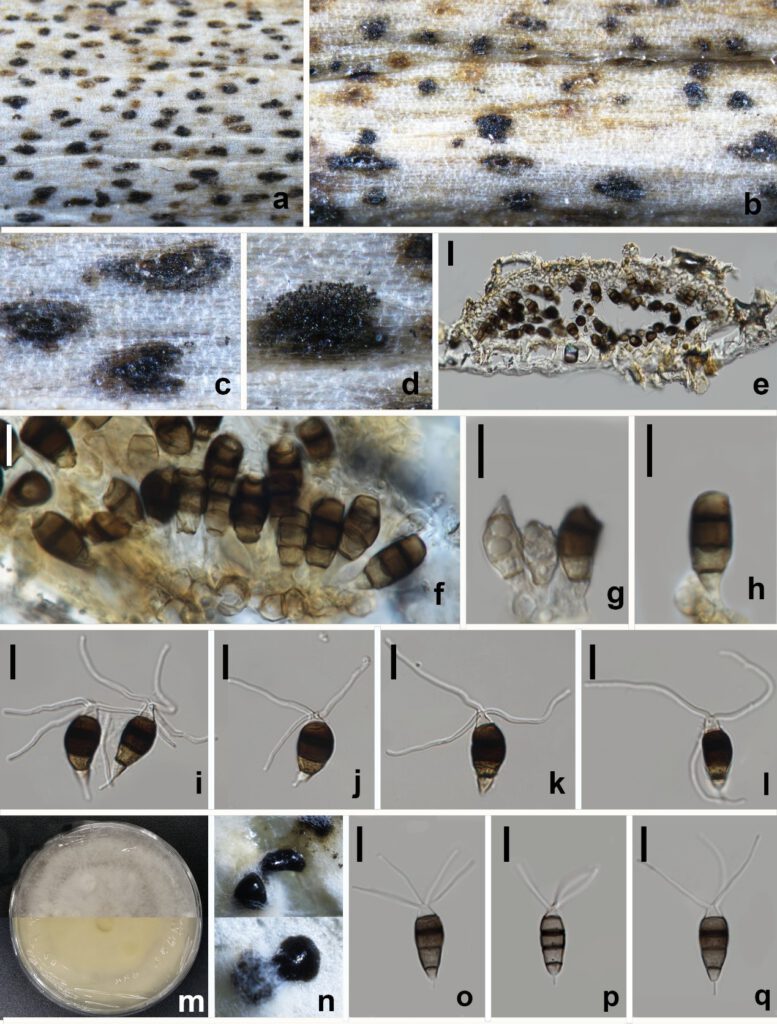Neopestalotiopsis paeoniae-suffruticosae W.L. Li & Jian K. Liu [as ‘paeonia-suffruticosa‘], in Li, Dissanayake, Zhang, Maharachchikumbura & Liu, Journal of Fungi 8(11, no. 1175): 12 (2022)
Index Fungorum number: IF 846757; MycoBank number: MB 846757; Facesoffungi number: FoF 12747;
Etymology – Name reflects the host plant it was isolated from, Paeonia suffruticosae
Holotype – HKAS 123212
Pathogenic on diseased branches of Paeonia suffruticosa Andr. Sexual morph: Not observed. Asexual morph: Conidiomata 88–92 μm high, 218–229 μm diam. (x̄ = 90 × 223, n = 15), globose, solitary, semi-immersed, black, excluding dark brown to black masses of conidia. Conidiomata wall 16–19 μm thick at sides, not well defined, comprising brown, thin-walled cells of textura angularis, with lighter cells at the base fusing into the host tissue. Conidiophores indistinct, often reduced to conidiogenous cells. Conidiogenous cells 5–6.5 × 2.5–3 μm (x̄ = 5.5 × 2.5 μm, n = 30), mostly integrated, ampulliform to lageniform, hyaline to light brown, smooth-walled, single, with truncated apex. Conidia 20–23 × 9–11 μm (x̄ = 21 × 9.5 μm, n = 30), fusoid, ellipsoid, straight to slightly curved, 4 septa; conical to obconical basal cell with a truncated base, hyaline, rough and thin-walled, 3–4 μm long, often with a small basal appendix; three medial cells with light brown to dark pigmentation with a rough wall, and one septum darker than the rest of the cell (second cell from the base pale brown, 4–5.5 μm; third cell golden brown 5.5–7 μm long; fourth cell brown, 4.5–6 μm long); apical cell of 2.5–3.5 μm long, hyaline, cylindrical, thin and smooth-walled with 3 apical tubular appendages, not arising from the apical crest, but each inserted at a different locus in the upper half of the apical cell, unbranched, filiform, flexuous, 22.5–34 μm; single basal appendix, tubular, unbranched, centric, 3.5–7.5 μm, mean conidium length/width ratio = 2.2:1.
Culture characteristics – Colonies on PDA reaching 70 mm diam. after 7 d at 25 ℃. Colonies filamentous to circular, medium dense, with white sparse mycelium, fruiting bodies black.
Material examined – China, Sichuan Province, Mianyang city, on a diseased branch of Paeonia suffruticosa, 10 September 2021, W.L. Li, YMD 342a (HKAS 123212, holotype), ex-type living culture, CGMCC3.23554; ibid., YMD 342b (HUEST 22.0033, isotype), ex-isotype living culture, UESTCC 22.0033.
Notes – Phylogenetically, Neopestalotiopsis paeonia-suffruticosa formed a distinct clade in the multi-locus tree and is sister to the clade containing N. cubana (CBS 600.96), N. mianyangensis (UESTCC 22.0006) and N. pandanicola (KUMCC 17–0175) in a poor-supported clade (Figure 2). Neopestalotiopsis paeonia-suffruticosa morphologically differs from N. cubana by longer conidiogenous cells (up to 12 μm vs.5–6.5 μm) and longer apical appendages (22.5–33.5 μm vs. up to 27 μm). Moreover, they are also different in six base pairs in tef1-a and one base pair in tub2 loci without gaps. Neopestalotiopsis pandanicola differs from N. paeonia-suffruticosa in having longer conidia (27–35 μm & 20–23 μm μm) with 2(–3) apical tubular appendages. Neopestalotiopsis mianyangensis morphologically differs from N. Paeonia-suffruticosa in having wider conidia (9–10 μm & 5.5–7) and longer appendages (apical appendages 22.5–34 μm &. 5.5–11 μm, basal appendages 3.5–7.5 μm &. 3–4 μm).

Figure 2 – Neopestalotiopsis paeonia-suffruticosae (HKAS 123212, holotype). a–d Appearance of conidiomata on the host. e Vertical section of conidiomata. f Sporodochia. g, h Conidiogenous cells and conidia. i–l, o–q Conidia. m Upper and reverse view of the colony (on PDA). n Appearance of conidia mass on PDA. Scale bars: e = 20 μm, f–l, o–q = 10 μm.
